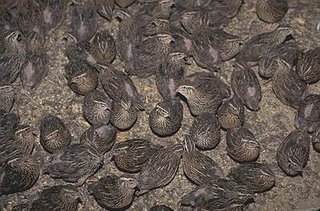
The quail has many advantages in comparison to any other small animal for home food production. The females begin to lay eggs at average of six weeks of age, and continue to produce eggs economically for at least a year. The extra males can be killed for meat at the age of 6 weeks. Even older animals are easy to butcher and can be prepared for food in a variety of ways. Birds need only a small amount of space. A cage permitting each bird 225 cm2 of floor space (44 birds per square meter) is the minimum requirement. The cage need not be more than 15 cm in height. Quail are efficient converters of feed. With each egg a female deposits an edible package of 8 percent of her own body weight (compared to 3 percent in the case of chickens).
On the other hand, quail have some disadvantages. The shrill crowing of the males can be disturbing. When males and females are mixed some males will peck at others so severely that they will blind them and eventually kill them. If not cleaned daily the cages can produce an odor. Quail are susceptible to some pests, parasites, and diseases that plague other poultry. Quail age more rapidly than other fowl and laying birds should be replaced each year. The chicks are quite small and tender, and easily destroyed by very small imperfections in their environment. They need to be protected in a brooder for 3 full weeks in the tropics. Once mature birds escape from cages they are difficult to recapture. During the short days of winter quail need supplementary lighting to keep them to keep them laying. A quail production system must take into account all of these points.
Below is a guide to Quail production:
1. Start with a pair that is 30-35 days old, with smooth feathers, and without streaks of white or black.
2. The pair must be of same stock. A Japanese quail weighs 100 grams at age 30-35 days, and 120 grams at 60 days. The older, the heavier.
